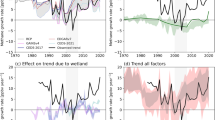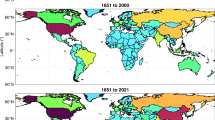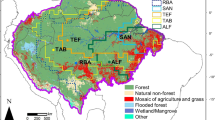Abstract
The global atmospheric methane burden has more than doubled since pre-industrial times1,2, and this increase is responsible for about 20% of the estimated change in direct radiative forcing due to anthropogenic greenhouse-gas emissions. Research into future climate change and the development of remedial environmental policies therefore require a reliable assessment of the long-term growth rate in the atmospheric methane load. Measurements have revealed that although the global atmospheric methane burden continues to increase2 with significant interannual variability3,4, the overall rate of increase has slowed2,5. Here we present an analysis of methane measurements from a global air sampling network that suggests that, assuming constant OH concentration, global annual methane emissions have remained nearly constant during the period 1984–96, and that the decreasing growth rate in atmospheric methane reflects the approach to a steady state on a timescale comparable to methane's atmospheric lifetime. If the global methane sources and OH concentration continue to remain constant, we expect average methane mixing ratios to increase slowly from today's 1,730 nmol mol−1 to ∼1,800 nmol mol−1, with little change in the contribution of methane to the greenhouse effect.
This is a preview of subscription content, access via your institution
Access options
Subscribe to this journal
Receive 51 print issues and online access
$199.00 per year
only $3.90 per issue
Buy this article
- Purchase on Springer Link
- Instant access to full article PDF
Prices may be subject to local taxes which are calculated during checkout


Similar content being viewed by others
References
Etheridge, D. M., Pearman, G. I. & Fraser, P. J. Changes in tropospheric methane between 1841 and 1978 from a high accumulation rate Antarctic ice core. Tellus 44, 282–294 (1992).
Dlugokencky, E. J., Steele, L. P., Lang, P. M. & Masarie, K. A. The growth rate and distribution of atmospheric methane. J. Geophys. Res. 99, 17021–17043 (1994).
Dlugokencky, E. J. et al. Changes in CH4and CO growth rates aftr the eruption of Mt. Pinatubo and their link with changes in tropical tropospheric UV flux. Geophys. Res. Lett. 23, 2761–2764 (1996).
Dlugokencky, E. J. et al. Adramatic decrease in the growth rate of atmospheric methane in the northern hemisphere during 1992. Geophys. Res. Lett. 21, 45–48 (1994).
Steele, L. P. et al. Slowing down of the global accumulation of atmospheric methane during the 1980's. Nature 358, 313–316 (1992).
Thoning, K. W., Tans, P. P. & Komhyr, W. D. Atmospheric carbon dioxide at Mauna Loa observatory, 2. Analysis of the NOAA GMCC data, 1974–1985. J. Geophys. Res. 94, 8549–8565 (1989).
Tans, P. P., Conway, T. J. & Nakazawa, T. Latitudinal distribution of the sources and sinks of atmospheric carbon dioxide derived from surface observations and an atmospheric transport model. J. Geophys. Res. 94, 5151–5172 (1989).
Hogan, K. B. & Harriss, R. C. Comment on ‘A dramatic decrease in the growth rate of atmospheric methane in the northern hemisphere during 1992’ by E. J. Dlugokencky et al. Geophys. Res. Lett. 21, 2445–2446 (1994).
Bekki, S., Law, K. S. & Pyle, J. A. Effect of ozone deletion on atmospheric CH4and CO. Nature 371, 595–597 (1994).
Lowe, D. C., Brenninkmeijer, C. A. M., Brailsford, G. W., Lassey, K. R. & Gomez, A. J. Concentration and 13C records of atmospheric methane in New Zealand and Antarctica:Evidence for changes in methane sources. J. Geophys. Res. 99, 16913–16925 (1994).
Prinn, R. G. et al. Atmospheric trends and lifetime of CH3CCl3and global OH concentrations. Science 269, 187–192 (1995).
Dlugokencky, E. J., Masarie, K. A., Tans, P. P., Conway, T. J. & Xiong, X. Is the amplitude of the CH4seasonal cycle changing? Atmos. Environ. 31, 21–26 (1997).
Prather, M. J. Time scales in atmospheric chemistry: Theory, GWPs for CH4and CO, and runaway growth. Geophys. Res. Lett. 23, 2597–2600 (1996).
Fung, I. et al. Three-dimensional model synthesis of the global methane cycle. J. Geophys. Res. 96, 13033–13065 (1991).
Cicerone, R. J. & Oremland, R. S. Biogeochemical aspects of atmospheric methane. Global Biogeochem. Cycles 2, 299–327 (1988).
Gupta, M. & Cicerone, R. Perturbation to global tropospheric photochemistry due to changes in latitudinal distributions of surface sources of CH4, CO, and NOx. Eos 78, 90 (1997).
Law, K. S. & Nisbet, E. G. Sensitivity of the CH4growth rate to changes in CH4emissions from natural gas and coal. J. Geophys. Res. 101, 14387–14397 (1996).
Hogan, K. B., Hoffman, J. S. & Thompson, A. M. Methane on the greenhouse agenda. Nature 354, 181–182 (1991).
Khalil, M. A. K. & Rasmussen, R. Decreasing trend of methane: unpredictability of future concentrations. Chemosphere 26, 803–814 (1993).
Schimel, D. et al. in Intergovernmental Panel on Climate Change (IPCC), Climate Change 1995, The Science of Climate Change 94 (Cambridge University Press, Cambridge, 1996).
Interactive Data Language Research Systems ( Boulder, Colorad, (1997).
Acknowledgements
We thank all agencies that have assisted us with the cooperative air sampling network, and Blue Star Line for their continued support of our sampling efforts. We are grateful for the efforts of all network observers, and thank T. Conway and R. Cicerone for comments. This work was supported in part by the Atmospheric Chemistry Proejct of the NOAA Climate and Global Change Program and the US Environmental Protection Agency.
Author information
Authors and Affiliations
Corresponding author
Rights and permissions
About this article
Cite this article
Dlugokencky, E., Masarie, K., Lang, P. et al. Continuing decline in the growth rate of the atmospheric methane burden. Nature 393, 447–450 (1998). https://doi.org/10.1038/30934
Received:
Accepted:
Issue Date:
DOI: https://doi.org/10.1038/30934
This article is cited by
-
Impact of interannual and multidecadal trends on methane-climate feedbacks and sensitivity
Nature Communications (2022)
-
Trend analysis of atmospheric temperature, water vapour, ozone, methane and carbon-monoxide over few major cities of India using satellite data
Journal of Earth System Science (2020)
-
Revisiting enteric methane emissions from domestic ruminants and their δ13CCH4 source signature
Nature Communications (2019)
-
Global ocean methane emissions dominated by shallow coastal waters
Nature Communications (2019)
-
Plant species, temperature, and bedrock affect net methane flux out of grassland and forest soils
Plant and Soil (2017)
Comments
By submitting a comment you agree to abide by our Terms and Community Guidelines. If you find something abusive or that does not comply with our terms or guidelines please flag it as inappropriate.



